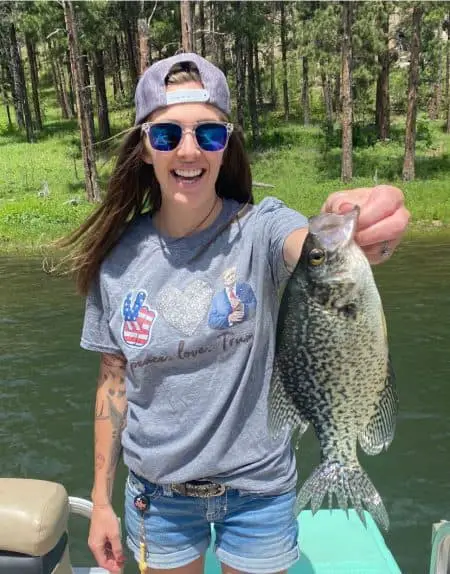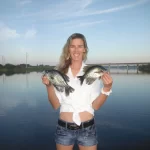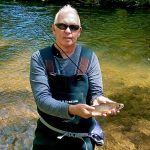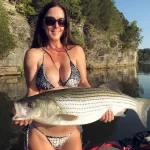Crappie Fishing Tackle – Complete Guide
This article will focus on crappie fishing tackle. Crappie are an extremely popular freshwater fish species. They are the largest of the “panfish” family. Crappie are taken by anglers using both live bait and artificial lures. They are beautiful, scrappy, and terrific eating. What more could an angler ask for? However, anglers do need the right tackle in order to be successful.
The best crappie fishing tackle consists of a 6′ to 6 1/2′ light spinning rod with a matching reel. This outfit will cover every crappie fishing situation. A selection of light jigs with plastic grub bodies will be needed as well. #2 to #6 hooks, floats, and split shot finishes off the crappie angler’s tackle box.

Capt Jim Klopfer runs fishing charters in Sarasota, Florida. The crappie tackle and lure recommendations are his personal choices based on his almost 50 years of fishing for crappie in Florida and other parts of the country.
Crappie fishing rods and reels
Crappie anglers have quite a choice when it comes to fishing rods and reels. Most opt for light spinning tackle. Some still prefer the time proven spincast outfits. A few anglers choose light conventional rigs. Some serious crappie addicts go for the long spider rods to troll many lines at once.
Spinning rods and reels for crappie fishing
Most anglers fishing for crappie do so using spinning tackle. This type of tackle is versatile, easy to use, and very affordable. Capt Jim still likes to cast to crappie or troll for them with a typical spinning outfit. Therefore, he prefers a light spinning rod that is 6′ to 6 1/2′ long and matched with a matching reel. This rig allows anglers to cast a very light jig as well as do some trolling.

Click on the link to shop Amazon for this $50 Quantum combo.
“Fishing Lido Key is a participant in the Amazon Associates Program, an affiliate advertising program designed to provide a means for sites to earn advertising fees by advertising and linking to Amazon. As an Amazon Associate I earn from qualifying purchases. ”
Spider rods and reels for crappie fishing
There is a specialized tactic for crappie fishing called “spider rigging”. This is where angler slow troll near submerged structure using several long rods. It is usually done from the bow with the rods extending out in front on the boat. However, anglers can do the same from the stern as well. These rods are long, up to 18 feet in length.

Varying the rod length and lure depth allows anglers to cover a lot of water in search of crappie. It also keeps the lines from tangling. Boat control is crucial! It does take some practice to master this skill. Capt Jim does not fish this way, but anglers can read more about fishing a spider rig in this link.
Anglers can shop Spider rods at Amazon from this link
Spin Cast rods and reels for crappie fishing
Some anglers still prefer the simplicity of spincast rods and reels. Most anglers, Capt Jim included, caught their first fish using these outfits. They are a good choice for children and novice anglers. They are also fine for experienced anglers as well.
Anglers can shop Amazon for spincast outfits in this link
Ice fishing for crappie

Many anglers enjoy ice fishing for crappie. Many of the same lures, baits and lines are the same used in open water fishing. However, due to the need to stand near the hole, the fishing rods are shorter. Very light lines are used in the clear, cold water. Capt Jim wrote a detailed article on ice fishing for crappie, anglers can read it in the link below.
Fishing line for crappie
Anglers have several choices for fishing line when crappie fishing. These are basically monofilament, flourocarbon, and braided line. Like most things in life, all have advantages and disadvantages. 6 lb test is a good all-round size. However, anglers may drop down in clear open water or go up higher in stained water or when fishing in heavy cover.

Monofilament fishing line
For most crappie anglers, monofilament line is the best choice. It is what Capt Jim prefers. Monofilament line is inexpensive and easy to use. Knots are easy to tie as well. Monofilament line stretches, and this is a good thing when it comes to crappie! They have very soft mouths and hooks will pull easily.
Click this link to shop Amazon for monofilament line
Flourocarbon fishing line
Flourocarbon line is excellent line to use for crappie. It is nearly invisible and does have a little stretch. The main down side to this line is the cost. Anglers who only use a couple of outfits might decide that it is worth the price.
Click this link to shop Amazon for Flourocarbon line

Braided fishing line
Braided line is very popular among many anglers, particularly with those chasing largemouth bass. The advantages of braided line are that it has almost no stretch, incredible sensitivity, and lasts a long time. However, the “zero stretch” aspect is not necessarily the best for crappie fishing. Anglers using braided line need soft rods and lightly set drags.
Click this link to shop Amazon for braided fishing line
Best crappie fishing lures
Many crappie are caught by anglers using live bait. Live minnows are by far the most popular live bait for crappie. However, artificial lures are very effective as well. Most lures imitate minnows, which is the primary forage of crappie.

Click to read about the best crappie fishing lure
Top 7 crappie fishing lures;
-
Blakemore Road Runner
-
Mister Twister grub
-
Johnson Beetle spin
-
Gulp Alive Minnow
-
Rapala Floating Minnow
-
Rooster Tail spinner
-
Bill Lewis Tiny Trap
The main advantages to lures are that they allow anglers to cover a lot of water as well as being more convenient. Lures can be stored and do not need to be kept alive. Trolling or casting lures will also generate reflex strikes from inactive fish.
1) Blakemore Roadrunner

The Blakemore Road Runner is Capt Jim’s go-to crappie fishing lure. It can be cast or trolled in all portions of the water column. It can even be fished under a float. The lure consists of a jig head, tail or dressing, and a spinner blade. It really combines two of the best freshwater lures; spinners and jigs.

While the Road Runners that come with marabou dressings are quite effective, Capt Jim prefers to add a grub tail to the bare jig head. This makes it easier to change colors and sizes. 1/16 to 1/8 ounces are the best sizes for most crappie fishing situations.
Productive colors vary greatly. Anglers should match the color to the water clarity being fished. Light colors work well in clear water. Darker colors are productive in stained water. Hot pink is good in muddy water. Chartreuse is a great all-round color.
Click this link to shop Amazon for Road Runner lures
2) Mister Twister curly tail grub

Mister Twister twister tail lures hit the market in the late 70’s. They have been catching a wide variety of fish species ever since! Crappie are certainly no exception. These baits have a tantalizing action in the water. The Mister Twister Teenie Grub is 2” long and perfect for crappie of all sizes.

The Mister Twister grub is most often fished on a jig head. The jig head provides weight for casting and depth control along with a hook. It also results in the action for which the “jig” gets it’s name. 1/8 ounce is a good all-round jig head size for crappie fishing. Colors vary, but the same rules regarding water clarity apply. Once again, chartreuse is a terrific choice for most applications.

The Mister Twister grub/jig head combo can also be added to a spinnerbait. This is an excellent bait for larger crappie. It will catch other panfish species as well as bass.
Click this link to shop Amazon for Mister Twister Teeny grubs
These lures work extremely well when trolled. This is particularly true in fairly shallow water. Anglers idling along a weed line or drop-off will find schools of crappie. In deeper water, a heavier jig head will be required. One deadly technique is to go back and forth over channel edges, allowing the jig to rise and fall with the slack line.
3) Johnson Beetlespin

Number three on Capt Jim’s list of the top artificial lures for crappie in the Johnson Beetle Spin. This is a simple, yet highly effective lure for crappie and other species. It is basically an undersized spinnerbait with a small grub on the business end. 1/16 is the best size for crappie, but anglers going after larger fish can bump up to the 1/8 ounce size.

The best aspect of the Beetle Spin is the simplicity. These baits are very easy to use! Anglers simply cast it out, allow it to sink, and use a slow, steady retrieve to bring it back in. The same approach applies to trolling; the slower the better, as long as the blades are turning.
Capt Jim does like darker colors such as black and green when using the Beetle Spin for crappie. As with most crappie lures, these baits will catch just about every freshwater species, particularly bluegill.
Click this link to shop Amazon for Beetle spin lures
4) Gulp Alive Minnow

The Gulp Alive Minnow in the 1” size is a terrific bait that combines fishing with both artificial lures and live bait. It can basically be substituted in any situation where live minnows are used. They have a great scent that will attract crappie to them.

The Gulp Minnow is generally used on a jig head. It can be fished with or without a float. Anglers also use them on bottom rigs and drop shot rigs. They have the advantage of fishing with live bait without the inconvenience. Gulp baits are a good choice when crappie are located and a bit fussy.
Click this link to shop Amazon for Gulp Alive Minnows
5) Rapala Floating Minnow

Plugs will certainly catch crappie, and in many cases larger specimens. Minnows are the number one forage for crappie. The Rapala Ultralight Minnow closely mimics a wounded bait fish. It has an erratic action that puts out both flash and vibration. It can be cast out and retrieved and is also productive when trolled.

For the most part, these lures are best used in shallow water. The lure floats at rest then dives down a few feet. This means that shallow weed beds and other flats are most productive. Spring and fall are usually the best times of year to fish this bait.
Click this link to shop Amazon for Rapala Ultralight Floating Minnow plugs
6) Rooster tail Spinner

The Rooster tail is a very good lure for catching crappie. It is very well known for fooling trout and is a bit underrated for crappie. It works very well in water 6 feet deep or less. Rooster tail lures are an excellent choice when crappie are scattered out over large flats. One “problem” with these spinners is that they catch so many different species that anglers will be spending time catching bluegill, bass, and other species.

Rooster tail lures are very easy to use. Like most freshwater baits with spinners, they work best when reeled back in using a slow, steady retrieve. Anglers can vary the depth fished by changing the sink time allowed. These lures can be trolled, but anglers must go very slowly.
Click this link to shop Amazon for Rooster Tail spinners
7) Rattletrap Tiny Trap

Anglers searching for big crappie and who enjoy “power fishing” will love fishing the Tiny Trap. This is a small version on the venerable Rattletrap. These are in the family of artificial fishing lures known as “lipless crankbaits”. They do not have a lip. Therefore, they do not dive down. Instead, they slowly sink and vibrate intensely when reeled back in.

Anglers can both cast and troll the tiny trap. This lure does work better with a fairly fast retrieve, as opposed to most bladed baits. A steady retrieve is usually used, but anglers can mix it up with pauses and twitches. It is a great “locator” bait that allows anglers to cover a lot of water when crappie fishing.
Click this link to shop Amazon for Tiny Trap plugs
Miscellaneous crappie gear
One nice aspect of crappie fishing is that a lot of extra gear is not necessarily required. For the most part, this is fairly basic fishing. The exception might be the anglers who get really into using spider rigs. Otherwise, it is just fairly light tackle, a handful of lures, a bit of tackle, and a couple extras.
Anglers who fish with live bait will obviously need some hooks. Fine wire hooks from size #2 down to size #6 will cover most crappie fishing situations. Anglers who mostly fish with lures can simply use a plane jig head to put a live minnow on if they like. A selection of split shot and sinkers along with some bobbers will also be required. A landing net is always a good idea, especially for fish like crappie with their soft mouths. Finally, anglers who fish with live minnows will need a bucket with a portable aerator.
Crappie fishing tips
It is often said that crappie are easy to catch but hard to find. For the most part, this statement has some truth to it. Crappie are not the most challenging of game fish to catch, once located. There are certainly days where they suspend and post front fish can be difficult to catch. However, the true challenge in crappie fishing is finding them.
Crappie are almost always found in schools, or at the very least scattered bunches. In deeper water, they will school up on some type of depth change. This is particularly true if cover is present. In man-made reservoirs, submerged channel edges of the original River are prime spots. Sloping points are another good place to look for crappie. Submerged timber or other types of structure will greatly enhance the chance of fish holding in these locations.
Shallow water crappie fishing
Crappie are found in fairly deep water for most of the year. The exception to this is in the spring when they move in close to the bank to spawn. For many anglers, this is the prime time to pursue these tasty freshwater pan fish. In many lakes, just about any brush pile and 328 foot of water will have crappie holding on them in the spring time.
This is a great time of year to use light spinning tackle and cast artificial lures. Since crappie are scattered about but highly aggressive, this is a fun and productive technique. All of the artificial lures listed above will catch crappie in the spring time. Many anglers fill their freezers this time of year and ignore crappie fishing in the other three seasons. This can be a mistake!
Deep water crappie fishing
Crappie are a bit more difficult to locate and catch when they school up in deeper water. However, anglers who put in the time to learn the patterns that crappie use in the summer, fall, and winter can experience some outstanding days. Anglers who do find crappie in deep water schools can experience nonstop action!
For the most part, vertical presentations work best when fishing for crappie in deeper water. This is a very efficient technique that keeps the bait or lure in the strike zone for the entire time. Jigs and live minnows are generally the most productive baits to use when fishing for crappie in this situation.
Trolling for crappie
Trolling is another excellent technique that anglers can use to locate crappie. Once again, lures that get down deep in the water column such as jigs, Road Runners, and Beetle spins are generally the best choice. Crank baits that will get down close to the water level being fished can work well, too.
One new method that has come about in recent years is spider rigging. In this method, anglers use several rods of varying lengths to thoroughly cover a wide swath as the angler trolls. Using varying length rods and different depths, anglers can quickly locate the depth that which crappie are feeding that day. Is a bit complicated regarding equipment. However, once mastered, it will put a lot a fish in the boat.
Crappie can be caught through the ice as well. These fish not only tolerate cold water, they feed and thrive in it. The same spots that produce in summer are often the best fishing spots for crappie he under the ice as well. Since a vertical presentation is really the only option, jigs and live minnows are the top baits to use.
Channel edges and deep water points are prime ice fishing spots for crappie. Anglers should drill multiple holes at several different depths and locations in order to quickly locate a school of fish. Once found, anglers can concentrate on that area. It is important to follow safety measures and make sure there’s plenty of ice before going out.
In conclusion, this article on crappie fishing and tackle should help anglers catch more of these very popular freshwater pan fish!






